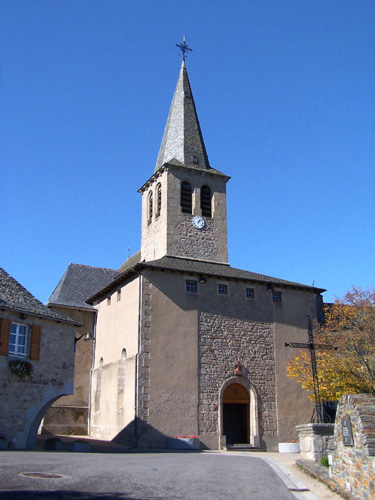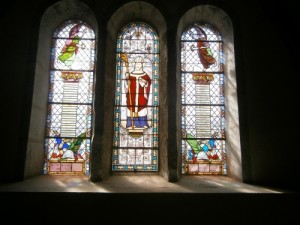L’église Saint-Martin est pré-romane, les premiers textes où elle apparaît, datent de la fin du XIe siècle. elle est située sur la route de Saint-Jacques de Compostelle et elle fut fortifiée au 14e me : c’est un édifice sur plan carré, surmonté d’une coupole octogonale à la croisée du transept; l’église a été désorientée; la porte actuelle correspond à l’ancien chœur, et on a rajouté 3 travées gothiques transversales formant le nouveau transept, et une autre faisant office de chœur; La nef fut recouverte à partir de 1374 de salles destinées à servir de fort-refuge; Elle possède aussi un souterrain partant du maître-autel. Un vitrail dans cette église martinienne est particulièrement intéressant puisque il représente le saint patron de l’église entouré des listes des morts de la guerre de 1914.
Saint Martin est représenté de manière assez exceptionnelle dans ce vitrail du XXe siècle de l’église Saint-Martin de Golinhac : l’évêque pose au milieu du groupe de trois vitraux en archevêque , le pallium est clairement visible; il tient la crosse épiscopale de la main droite et dans la main gauche une liste sur papier. Les deux vitraux qui l’entourent affichent la liste des morts du village pendant la guerre de 14-18. chacune des listes est surmontée par un ange tenant une couronne de martyr en l’honneur des morts de la guerre.
Ce groupe de trois vitraux présente une scène unique qui met en avant le rôle de Martin comme protecteur des soldats d’une part et surtout qui lie la date traditionnelle de la Saint-Martin d’hiver le 11 novembre et l’armistice de la guerre. L’association du saint et des soldats de 14-18 est très fréquente surtout dans la région du Nord de la France où les destructions ont donné naissance à une floraison d’églises reconstruites.
The church of Saint Martin is pre-Romanesque, the first texts in which it appears date from the end of the 11th century. It is situated on the route to Santiago de Compostela and was fortified in the 14th century: It is a square-plan building, topped by an octagonal dome at the transept crossing; the church has been disoriented; the present doorway corresponds to the old chancel, and three transverse Gothic bays have been added to form the new transept, and another serving as a chancel; the nave was covered from 1374 onwards with rooms intended to serve as a fort-refuge; it also has an underground passageway leading from the main altar. A stained glass window in this Martinian church is particularly interesting as it represents the patron saint of the church surrounded by lists of the dead of the 1914 war.
Saint Martin is represented in a rather exceptional way in this 20th century stained glass window in the church of Saint Martin in Golinhac: the bishop poses in the middle of the group of three stained glass windows as an archbishop, the pallium is clearly visible; he is holding the episcopal crosier in his right hand and a list on paper in his left hand. The two surrounding windows display the list of the dead of the village during the First World War. Each list is surmounted by an angel holding a martyr’s crown in honour of the war dead.
This group of three stained glass windows presents a unique scene which highlights the role of Martin as the protector of soldiers on the one hand and, above all, links the traditional date of St Martin’s Day on 11 November with the armistice of the war. The association of the saint with the soldiers of the First World War is very common, especially in the northern part of France where the destruction has given rise to a flourishing of rebuilt churches.

 "/>
"/>
